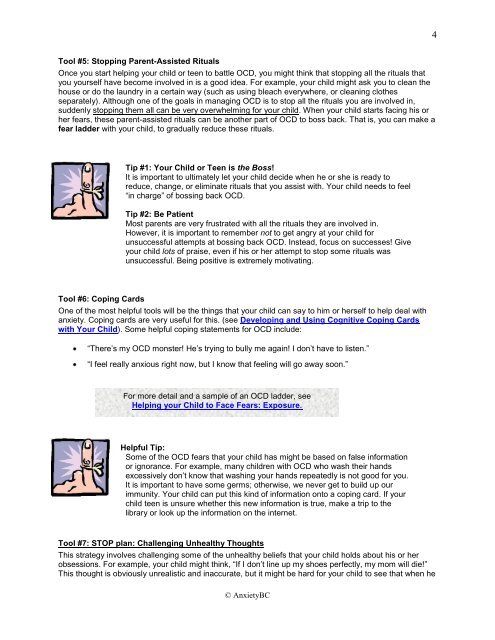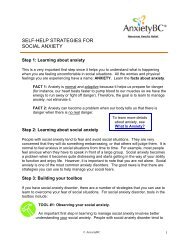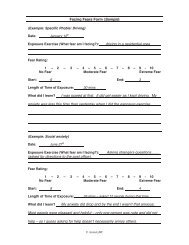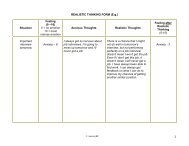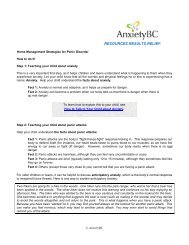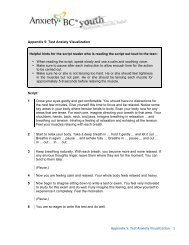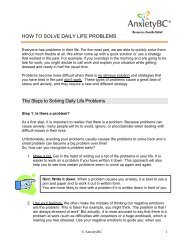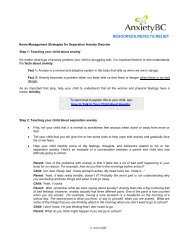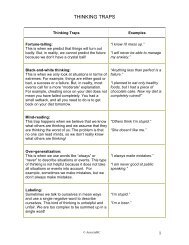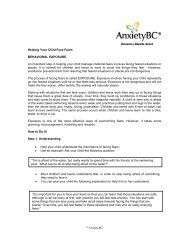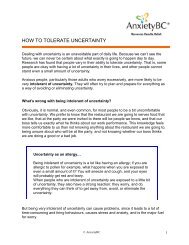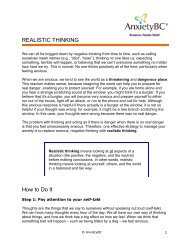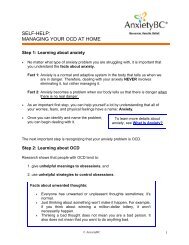Home Management Strategies for OCD - Anxiety BC
Home Management Strategies for OCD - Anxiety BC
Home Management Strategies for OCD - Anxiety BC
Create successful ePaper yourself
Turn your PDF publications into a flip-book with our unique Google optimized e-Paper software.
Tool #5: Stopping Parent-Assisted Rituals<br />
Once you start helping your child or teen to battle <strong>OCD</strong>, you might think that stopping all the rituals that<br />
you yourself have become involved in is a good idea. For example, your child might ask you to clean the<br />
house or do the laundry in a certain way (such as using bleach everywhere, or cleaning clothes<br />
separately). Although one of the goals in managing <strong>OCD</strong> is to stop all the rituals you are involved in,<br />
suddenly stopping them all can be very overwhelming <strong>for</strong> your child. When your child starts facing his or<br />
her fears, these parent-assisted rituals can be another part of <strong>OCD</strong> to boss back. That is, you can make a<br />
fear ladder with your child, to gradually reduce these rituals.<br />
Tool #6: Coping Cards<br />
Tip #1: Your Child or Teen is the Boss!<br />
It is important to ultimately let your child decide when he or she is ready to<br />
reduce, change, or eliminate rituals that you assist with. Your child needs to feel<br />
“in charge” of bossing back <strong>OCD</strong>.<br />
Tip #2: Be Patient<br />
Most parents are very frustrated with all the rituals they are involved in.<br />
However, it is important to remember not to get angry at your child <strong>for</strong><br />
unsuccessful attempts at bossing back <strong>OCD</strong>. Instead, focus on successes! Give<br />
your child lots of praise, even if his or her attempt to stop some rituals was<br />
unsuccessful. Being positive is extremely motivating.<br />
One of the most helpful tools will be the things that your child can say to him or herself to help deal with<br />
anxiety. Coping cards are very useful <strong>for</strong> this. (see Developing and Using Cognitive Coping Cards<br />
with Your Child). Some helpful coping statements <strong>for</strong> <strong>OCD</strong> include:<br />
“There’s my <strong>OCD</strong> monster! He’s trying to bully me again! I don’t have to listen.”<br />
“I feel really anxious right now, but I know that feeling will go away soon.”<br />
For more detail and a sample of an <strong>OCD</strong> ladder, see<br />
Helping your Child to Face Fears: Exposure.<br />
Helpful Tip:<br />
Some of the <strong>OCD</strong> fears that your child has might be based on false in<strong>for</strong>mation<br />
or ignorance. For example, many children with <strong>OCD</strong> who wash their hands<br />
excessively don’t know that washing your hands repeatedly is not good <strong>for</strong> you.<br />
It is important to have some germs; otherwise, we never get to build up our<br />
immunity. Your child can put this kind of in<strong>for</strong>mation onto a coping card. If your<br />
child teen is unsure whether this new in<strong>for</strong>mation is true, make a trip to the<br />
library or look up the in<strong>for</strong>mation on the internet.<br />
Tool #7: STOP plan: Challenging Unhealthy Thoughts<br />
This strategy involves challenging some of the unhealthy beliefs that your child holds about his or her<br />
obsessions. For example, your child might think, “If I don’t line up my shoes perfectly, my mom will die!”<br />
This thought is obviously unrealistic and inaccurate, but it might be hard <strong>for</strong> your child to see that when he<br />
© <strong>Anxiety</strong><strong>BC</strong><br />
4


